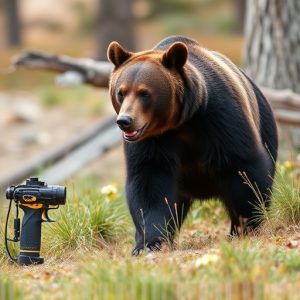Bear Spray vs. Regular Pepper Spray: Active Ingredient Insights & Effectiveness
Bear spray, containing pure capsaicin oleoresin from chili peppers, is a specialized self-defense to…….
Bear spray, containing pure capsaicin oleoresin from chili peppers, is a specialized self-defense tool for encounters with bears. Unlike regular pepper spray targeting human aggressors, it offers higher concentrations and longer range to deter and repel bears without causing lethal harm. The key component, capsaicins, irritate bears' eyes, nose, and respiratory tract, temporarily blinding and disorienting them. Bear spray's dense cloud of vapor provides hikers and outdoor enthusiasts crucial time to retreat or seek help in unexpected bear encounters. Its higher potency and targeted effects make it a game-changer for bear safety compared to regular pepper spray. However, proper usage guidelines, including line of sight, range, and wind conditions, are essential for effective and safe application.
“Unraveling the secrets of bear spray, a powerful self-defense mechanism in the wild, especially against aggressive bears. This article delves into the unique capabilities of capsaicin oleoresin, the key ingredient making bear spray distinct from regular pepper spray. We explore its effectiveness, safety measures, and why understanding these differences is crucial for anyone venturing into bear country. Get ready to navigate through this essential guide, ‘Bear Spray vs. Regular Pepper Spray,’ and equip yourself with vital knowledge.”
- Understanding Bear Spray: A Unique Self-Defense Tool
- The Power of Capsaicin Oleoresin: Unlocking the Active Ingredient
- Bear Spray vs. Regular Pepper Spray: Key Differences
- How Effective is Bear Spray Against Bears?
- Safety and Usage Guidelines for Bear Spray
Understanding Bear Spray: A Unique Self-Defense Tool
Bear spray is a specialized self-defense tool designed specifically for use against bears, offering a unique solution to potential encounters in their natural habitats. Unlike regular pepper spray, which primarily targets human aggressors, bear spray utilizes specific active ingredients tailored to deter and disable bears. The key component, capsaicin oleoresin, is derived from chili peppers and known for its effectiveness in causing temporary blindness, reduced mobility, and pain in bears, providing hikers and outdoor enthusiasts a crucial advantage when facing these powerful animals.
In comparison, regular pepper spray uses a blend of capsaicin and other chemicals to incapacitate human assailants. While it’s an excellent deterrent for close-range interactions, its effects are less impactful on larger, more aggressive wildlife like bears. Bear spray, with its higher concentration of pure capsaicin oleoresin, creates a significant barrier, giving individuals precious time to retreat or seek help during unexpected bear encounters in remote areas.
The Power of Capsaicin Oleoresin: Unlocking the Active Ingredient
Capsaicin oleoresin, the secret weapon in bear spray, is a potent compound that sets it apart from regular pepper spray. This natural ingredient, derived from chili peppers, harnesses the power of capsaicins, which are responsible for the heat and irritation sensation in our mouths when we consume spicy foods. In the context of bear spray, capsaicin oleoresin acts as a powerful deterrent by targeting the bear’s sensory system.
Unlike regular pepper spray, which often relies on synthetic chemicals, bear spray utilizes the active ingredient’s ability to irritate the eyes, nose, and respiratory tract of bears, causing them to avoid the area. This natural approach offers several advantages, including reduced environmental impact and a more targeted effect, making it an effective solution for outdoor enthusiasts navigating bear country.
Bear Spray vs. Regular Pepper Spray: Key Differences
When it comes to personal protection against bears, many people opt for bear spray instead of regular pepper spray. The key difference lies in their active ingredients and effectiveness. Bear spray typically contains a concentrated form of capsaicin oleoresin, derived from chili peppers. This ingredient is specifically designed to disrupt a bear’s sense of smell and taste, causing it to retreat. In contrast, regular pepper spray often uses various synthetic chemicals as its active ingredient, which can be less effective against larger predators like bears.
The potency and range are also distinct factors. Bear spray is formulated to create a dense cloud of vapor when sprayed, ensuring the capsaicin reaches the bear’s eyes, nose, and mouth from a farther distance. This feature is crucial for outdoor enthusiasts in bear country, as it provides an extra layer of safety during encounters. Regular pepper spray, on the other hand, tends to have a shorter range and may not be as effective against aggressive bears due to its direct contact nature.
How Effective is Bear Spray Against Bears?
Bear spray, a specialized defense mechanism, has established itself as a vital tool for hikers and outdoor enthusiasts navigating bear-infested territories. Its effectiveness against bears sets it apart from regular pepper spray. The key active ingredient in bear spray is capsaicin oleoresin, derived from chili peppers. This compound provokes an intense reaction when inhaled by bears, temporarily disorienting them and creating a safe escape route for humans.
In comparison to regular pepper spray, which primarily targets human aggressors, bear spray is formulated with higher concentrations of capsaicin to account for the larger size and varied behaviors of bears. This specialization ensures that bear spray remains non-lethal while effectively deterring and repelling these wild animals. Studies have shown that when used correctly, bear spray can reduce bear attacks by up to 80%, making it a game-changer in bear safety protocols.
Safety and Usage Guidelines for Bear Spray
Bear spray, as compared to regular pepper spray, is designed with specific safety and usage guidelines in mind due to its potent active ingredient—oleoresin capsaicin. This unique blend makes bear spray highly effective against aggressive bears, but it also necessitates careful handling and application. When using bear spray, always ensure you have a clear line of sight of the approaching bear. Aim for the face and eyes, as this is where capsaicin oleoresin takes effect, temporarily blinding and disorienting the animal.
It’s crucial to follow the recommended range of use—typically around 20-30 feet (6-9 meters)—and do not spray in windy conditions, as it may blow back onto you. Bear spray should only be used as a last resort when faced with an immediate threat from a bear. After spraying, back away slowly while keeping an eye on the bear’s behavior; if it continues to charge, seek shelter or use another defense mechanism. Regular pepper spray, while effective against humans and smaller wildlife, is generally less potent and has a shorter range than bear spray, making it less ideal for large bears.
In conclusion, bear spray, particularly its key active ingredient capsaicin oleoresin, offers a unique self-defense solution against aggressive bears. When compared to regular pepper spray, bear spray is specifically designed and significantly more effective in deterring bear encounters. Understanding the safety guidelines and proper usage is crucial for ensuring its effectiveness during outdoor activities in bear country.


